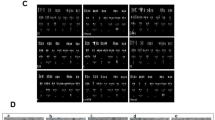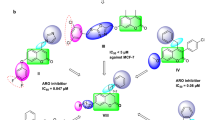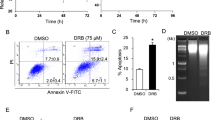Abstract
Aim:
To investigate the effects of a novel dithiocarbamate derivative TM208 on human breast cancer cells as well as the pharmacokinetic characteristics of TM208 in human breast cancer xenograft mice.
Methods:
Human breast cancer MCF-7 and MDA-MB-231 cells were treated with TM208 or a positive control drug tamoxifen. Cell proliferation was examined using SRB and colony formation assays. Cell apoptosis was analyzed with Annexin V-FITC/PI staining assay. Protein expression was examined with Western blot, ELISA and immunohistochemical analyses. MCF-7 breast cancer xenograft nude mice were orally administered TM208 (50 or 150 mg·kg−1·d−1) or tamoxifen (50 mg·kg−1·d−1) for 18 d. On d 19, the tumors were collected for analyses. Blood samples were collected from the mice treated with the high dose of TM208, and plasma concentrations of TM208 were measured using LC-MS/MS.
Results:
Treatment of MCF-7 and MDA-MB-231 cells with TM208 dose-dependently inhibited the cell proliferation and colony formation in vitro (the IC50 values were 36.38±3.77 and 18.13±0.76 μmol/L, respectively). TM208 (20–150μmol/L) dose-dependently induced apoptosis of both the breast cancer cells in vitro. In MCF-7 breast cancer xenograft nude mice, TM208 administration dose-dependently reduced the tumor growth, but did not result in the accumulation of TM208 or weight loss. TM208 dose-dependently inhibited the phosphorylation of EGFR and ERK1/2 in both the breast cancer cells in vitro as well as in the MCF-7 xenograft tumor.
Conclusion:
Inhibition of EGFR autophosphorylation plays an important role in the anticancer effect of TM208 against human breast cancer.
Similar content being viewed by others
Log in or create a free account to read this content
Gain free access to this article, as well as selected content from this journal and more on nature.com
or
References
Al Olayan A, Al Hussaini H, Jazieh AR . The roles of epidermal growth factor receptor (EGFR) inhibitors in the management of lung cancer. J Infect Public Health 2012; 5: S50–60.
Murray S, Dahabreh IJ, Linardou H, Manoloukos M, Bafaloukos D, Kosmidis P . Somatic mutations of the tyrosine kinase domain of epidermal growth factor receptor and tyrosine kinase inhibitor response to TKIs in non-small cell lung cancer: an analytical database. J Thorac Oncol 2008; 3: 832–9.
Woodburn JR . The epidermal growth factor receptor and its inhibition in cancer therapy. Pharmacol Ther 1999; 82: 241–50.
Nicholson RI, Gee JM, Harper ME . EGFR and cancer prognosis. Eur J Cancer 2001; 37: 9–15.
Abd EI-Rehim DM, Pinder SE, Paish CE, Bell JA, Rampaul RS, Blamey RW, et al. Expression and co-expression of the members of the epidermal growth factor receptor (EGFR) family in invasive breast carcinoma. Br J Cancer 2004; 91: 1532–42.
Salomon DS, Brandt R, Ciardiello F, Normanno N . Epidermal growth factor-related peptides and their receptors in human malignancies. Crit Rev Oncol Hematol 1995; 19: 183–232.
Liebmann C . Regulation of MAP kinase activity by peptide receptor signalling pathway: paradigms of multiplicity. Cell Signal 2001; 13: 777–85.
Hill CS, Treisman R . Transcriptional regulation by extracellular signals: mechanisms and specificity. Cell 1995; 80: 199–211.
Garrett JT, Sutton CR, Kuba MG, Cook RS, Arteaga CL . Dual blockade of HER2 in HER2-overexpressing tumor cells does not completely eliminate HER3 function. Clin Cancer Res 2013; 19: 610–9.
Farnie G, Clarke RB, Spence K, Pinnock N, Brennan K, Anderson NG, et al. Novel cell culture technique for primary ductal carcinoma in situ: role of Notch and epidermal growth factor receptor signaling pathways. J Natl Cancer Inst 2007; 99: 616–27.
Li X, Lewis MT, Huang J, Gutierrez C, Osborne CK, Wu MF, et al. Intrinsic resistance of tumorigenic breast cancer cells to chemotherapy. J Natl Cancer Inst 2008; 100: 672–9.
Len C, Boulognemerlot AS, Postel D . Synthesis and antifungal activity of novel bis(dithiocarbamate) derivatives of glycerol. J Agric Food Chem 1996; 44: 2856–8.
Cascio G, Lorenzi L, Caglio D, Manghisi E, Arcamone F, Guanti G, et al. Synthesis and antibacterial activity of C-4 thio-and dithiocarbamate monobactam derivatives. Farmaco 1996; 51: 189–96.
Lai CS . Preparation of conjugates of dithiocarbamates with drugs. P. PCT Int. Appl, WO 9855453 A1, 1998-12-10 (66).
Hidaka S, Funakoshi T, Shimada H, Tsuruoka M, Kojima S . Comparative effects of diethyldithiocarbamate and N-benzyl-D-glucamine dithiocarbamate on cis-diamminedichloroplatinum-induced toxicity in kidney and gastrointestinal tract in rats. J Appli Toxicol 1995; 15: 267–73.
Guo BG, Ge ZM, Cheng TM . Synthesis and anti-tumor activity of 1,4-bis[3-(aminodithiocarboxyl) propionyl] pipera-zine derivatives. Acta Pharm Sinica 2001; 36: 185–7.
Ge ZM, Li RT, Cheng TM, Cui JR . Synthesis and biological activities of dipiperazinium salts containing dithiocarboxyl. Arch Pharm Pharm Med Chem 2001; 334: 173–6.
Li RT, Cheng TM, Cui JR . Study on the synthesis and anticancer activity of dithiocarbamate. US patent: 1328999, 2002–01.
Li RT, Cheng TM, Cui JR . Piperazine mono(dithio)-carbamate ester compounds and analog: preparation method and pharmaceutical use. US patent: 10/157733, 2002-05; WO Apply No: PCT/US02/16772, 2002–5.
Li RD, Zhang X, Li QY, Ge ZM, Li RT . Novel EGFR inhibitors prepared by combination of dithiocarbamic acidesters and 4-anilinoquinazolines. Bioorg Med Chem Lett 2011; 21: 3637–40.
Guo W, Rang FX, Wang RQ, Cui JR, Li RT, Cheng TM, et al. Antitumor effect of hydrochloride 4-methyl-piperazine-1-carbodithioc acid 3-cyano-3,3-diphenyl-propyl ester. Chin J Clin Pharmacol Ther 2004; 9: 59–62.
Zhang N, Guo W, Wang L, Huang W, Xu B, Ge ZM, et al. Effect of TM208 on QGY-7703 xenograft tumor growth. Anticancer Drugs 2008; 19: 593–8.
Jiang X, Ling X, Han F, Li R, Cui J . Studies on the metabolism of 4-methyl-piperazine-1-carbodithioc acid 3-cyano-3,3-diphenylpropyl ester hydrochloride in rats by high-performance liquid chromatography/electrospray ionization tandem mass spectrometry. J Pharm Biomed Anal 2007; 44: 1127–32.
Kakuta Y, Pedersen LC, Chae K, Song WC, Leblanc D, London R, et al. Mouse steroid sulfotransferases: substrate specificity and preliminary X-ray crystallographic analysis. Biochem Pharmacol 1998; 55: 313–7.
Ji X, Chen Y, Li R, Zhou T, Lu W . A high-sensitivity LC-MS/MS method for the determination of 4-methyl-piperazine-1-carbodithioc acid 3-cyano-3, 3-diphenylpropyl ester hydrochloride in rat plasma and its application to a pharmacokinetics study. Biomed Chromatogr 2012; 26: 1196–201.
Lurje G, Lenz HJ . EGFR signaling and drug discovery. Oncology 2009; 77: 400–10.
Mamot C, Drummond DC, Greiser U, Hong K, Kirpotin DB, Marks JD, et al. Epidermal Growth Factor Receptor (EGFR)-targeted Immunoliposomes Mediate Specific and Efficient Drug Delivery to EGFR- and EGFRvIII-overexpressing Tumor Cells. Cancer Res 2003; 63: 3154–61.
Jordan VC . Tamoxifen (ICI46,474) as a targeted therapy to treat and prevent breast cancer. Br J Pharmacol 2006; 147: 269–76.
Jordan VC, Morrow M . Tamoxifen, raloxifene, and the prevention of breast cancer. Endocr Rev 1999; 20: 253–78.
Brinkman JA, El-Ashry D . ER re-expression and re-sensitization to endocrine therapies in ER-negative breast cancers. J Mammary Gland Biol Neoplasia 2009; 14: 67–78.
Zhou J, Yu Q, Chen R, Seeger H, Fehm T, Cahill MA, et al. Medroxyprogesterone acetate-driven increase in breast cancer risk might be mediated via cross-talk with growth factors in the presence of progesterone receptor membrane component-1. Maturitas 2013; 76: 129–33.
Bayliss J, Hilger A, Vishnu P, Diehl K, El-Ashry D . Reversal of the estrogen receptor negative phenotype in breast cancer and restoration of antiestrogen response. Clin Cancer Res 2007; 13: 7029–36.
Xu Y, Liu X, Guo F, Ning Y, Zhi X, Wang X, et al. Effect of estrogen sulfation by SULT1E1 and PAPSS on the development of estrogen-dependent cancers. Cancer Sci 2012; 103: 1000–9.
Gong H, Jarzynka MJ, Cole TJ, Lee JH, Wada T, Zhang B, et al. Glucocorticoids antagonize estrogens by glucocorticoid receptor-mediated activation of estrogen sulfotransferase. Cancer Res 2008; 68: 7386–93.
Magkou C, Nakopoulou L, Zoubouli C, Karali K, Theohari I, Bakarakos P, et al. Expression of the epidermal growth factor receptor (EGFR) and the phosphorylated EGFR in invasive breast carcinomas. Breast Cancer Res 2008; 10: R49.
Acknowledgements
This work was supported by the National Natural Science Foundation of China (NSFC) [Grant 81273583].
Author information
Authors and Affiliations
Corresponding authors
Rights and permissions
About this article
Cite this article
Ji, Xw., Li, Rt., Li, Zq. et al. Inhibition of EGFR autophosphorylation plays an important role in the anti-breast cancer efficacy of the dithiocarbamate derivative TM208. Acta Pharmacol Sin 35, 239–247 (2014). https://doi.org/10.1038/aps.2013.156
Received:
Accepted:
Published:
Issue date:
DOI: https://doi.org/10.1038/aps.2013.156
Keywords
This article is cited by
-
Pharmacokinetic-pharmacodynamic modeling of the antitumor effect of TM208 and EGFR-TKI resistance in human breast cancer xenograft mice
Acta Pharmacologica Sinica (2016)
-
Intratumoral estrogen sulfotransferase induction contributes to the anti-breast cancer effects of the dithiocarbamate derivative TM208
Acta Pharmacologica Sinica (2015)



